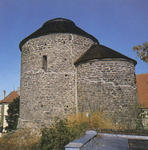
Znojmo was an important royal town, which still presents many gothic, renaissance, and baroque houses,
a romantic rotunda to Saint Catherine and precious sacred structures. The town is well known for its vineyards and its cucumbers. It's annual wine festivals are well attended. Znojmo has a resident population of approximately 37 000. After Moravia was joined to the Czech state in the first half of the 11
th century, the town of Znojmo arose on a rocky headland above the river Dyje. It was to become the seat of the later non-reigning princes of the house of Premysl founded at that time by the Czech prince, Bretislav. About the middle of that century the rotunda of St. Catherine, originally of the Virgin, was built on the outer defences of the town. This was a simple vaulted structure with a horseshoe apse, evidently recalling
older architecture of the Greater Moravian Empire. It contains remarkable mural paintings with an iconographical design unique in Bohemia.
The Znojmo area was settled as early as the paleolithic age, as has been proved by many archeological findings. It has been populated continuously since the sixth century, when the Slavs came to southern Moravia. The history of Znojmo is connected with the establishment of the old Slavic fortified settlement of St. Hippolyte in the ninth to tenth century, one of the major fortresses of Great Moravia. At the beginning of the eleventh century, after Great Moravia fell apart, the Znojmo princedom arose, in the form of a castle and a church - the Rotunda of the Virgin Mary. In 1226, the settlements joined together and King Premysl Otakar I. elevated them to the status of a city.
Znojmo's rotunda, woven with various mysteries, stands on the highest point of the castle courtyard. Wholly inconspicuous as regards its outer appearance, it surprises the visitor with its magnificent pictorial
decoration of the Slavonic Middle Ages. It is unique in the Czech Lands as a whole. Here the church theme, represented in particular by a Marian cycle, is skilfully combined with secular motifs which portray the princes of the Premyslid dynasty from its mythical founder Premysl the Ploughman up to historically documented members of the Bohemian and Moravian branches, including the first Czech king Vratislav II.
 Guide
Guide 

